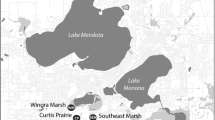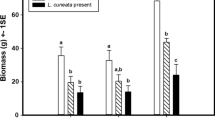Abstract
Conflicting interpretations of the negative impacts of invasive species can result if inconsistent measures are used among studies or sites in defining the dominance of these species relative to the communities they invade. Such conflicts surround the case of Lythrum salicaria (purple loosestrife), a widespread exotic wetland perennial. We describe here a 1999 study in which we quantified stand characteristics of L. salicaria and associated vegetation in arrays of 30 1-m2 plots in each of five wet meadows in Connecticut, USA. We explored linear and non-linear relationships of above-ground plant biomass, stem density, and indices of species richness, diversity, and composition to gradients of L. salicaria dominance, including stem density, percent cover, and biomass. Species richness, other diversity metrics, and stem density of other species were not significantly correlated with the density or percent cover of L. salicaria stems. The relative importance values (number of quadrats in which they were found) of co-occurring species in low-density L. salicaria quadrats were significantly correlated with their relative importance in high-density L. salicaria quadrats, indicating that only modest shifts in abundance occurred as L. salicaria increased in density. No individual species were consistently associated with or repelled by the presence of L. salicaria across sites. In contrast to density and diversity features, however, the total biomass of species other than L. salicaria was significantly, negatively correlated with the total biomass of L. salicaria at each site surveyed. Lythrum salicaria in pure, dense stands maintained a greater above-ground standing biomass on invaded sites than uninvaded vegetation of similar physiognomy. This study demonstrates that hypotheses about L. salicaria effects can vary depending upon the ecological metric that is examined. Where one-time, correlative studies are the most feasible option, data taken on a range of metrics—especially biomass—should be taken to inform us about mechanisms by which L. salicaria invades and predominates in wetlands.
Similar content being viewed by others
Literature Cited
Anderson, M. G.. 1995. Interactions between Lythrum salicaria and native organisms: a critical review. Environmental Management 19:225–231.
Blossey, B., L. C. Skinner, and J. Taylor. In press. Impact and management of Purple loosestrife (Lythrum salicaria) in North America. Biodiversity and Conservation.
Blossey, B.. 1999. Before, during and after: the need for long-term monitoring in invasive plant species management. Biological Invasions 1:301–311.
Blossey, B., D. Schroeder, S. D. Hight, R. A. Malecki. 1994. Host-specificity and enviromental impact of two leaf beetles (Galerucella calmariensis and G. pusilla) for biological control of purple loosestrife (Lythrum salicaria). Weed Science 42:124–140.
Brown, B. J.. 1999. The impact of an invasive species (Lythrum salicaria) on pollination and reproduction of a native species (L. alatum). Ph.D. Thesis. Kent State University. Kent, OH, USA.
Cowardin, L. M., V. Carter, F. C. Golet, and E. T. LaRoe. 1979. Classification of Wetlands and Deepwater Habitats of the United States. U. S. Fish and Wildlife Service, Washington DC, USA. FWS/OBS-79/31.
Dale, M. R. T.. 1999. Spatial Pattern Analysis in Plant Ecology. Cambridge Studies in Ecology, Cambridge University Press, Cambridge, UK.
Emery, S. L. and J. A. Perry. 1995. Aboveground biomass and phosphorus concentrations of Lythrum salicaria (Purple Loosestrife) and Typha spp. (Cattail) in 12 Minnesota wetlands. American Midland Naturalist 134:394–399.
Gabor, T. S., T. Haagsma, and H. R. Murkin. 1996. Wetland plant responses to varying degrees of purple loosestrife removal in southeastern Ontario, Canada. Wetlands 16:95–98.
Galatowitsch, S. M., N. O. Anderson, and P. D. Ascher. 1999. Invasiveness in wetland plants in temperate North America. Wetlands 19:733–755.
Gaudet, C. L. and P. A. Keddy. 1988. A comparative approach to predicting competitive ability from plant traits. Nature 334:242–243.
Gaudet, C. L. and P. A. Keddy. 1995. Competitive performance and species distribution in shoreline plant communities: a comparative approach. Ecology 76:280–291.
Geotoxi Associates, Inc. 1995. Wetland resource evaluation and impact assessment: proposed Seman Park, Town of Southbury, Connecticut. Glastonbury, CT, USA.
Gleason, H. A. and A. Cronquist. 1991. Manual of Vascular Plants of the Northeastern United States and Adjacent Canada. 2nd Edition. New York Botanical Garden. Bronx, NY, USA.
Hager, H. A. and K. D. McCoy. 1998. The implications of accepting untested hypotheses: a review of the effects of purple loosestrife (Lythrum salicaria) in North America. Biodiversity and Conservation 7:1069–1079.
Keddy, P. A., L. Twolan-Strutt, and I. C. Wisheu. 1994. Competitive effect and response rankings in 20 wetland plants: are they consistent across three environments? Journal of Ecology 82:635–643.
Mack, R. N.. 1996. Predicting the identity and fate of plant invaders: emergent and emerging approaches. Biological Conservation 78: 107–121.
Mack, R. N., D. Simberloff, W. M. Lonsdale, H. Evans, M. Clout, and F. A. Bazzaz. 2000. Biotic invasions: causes, epidemiology, consequences, and control. Ecological Applications 10:689–710.
Magee, D. W. and H. E. Ahles. 1999. Flora of the Northeast: A Manual of the Vascular Flora of New England and Adjacent New York. University of Massachusetts Press, Amherst, MA, USA.
Mal, T. K., J. Lovett-Doust, and L. Lovett-Doust. 1997. Time-dependent competitive displacement of Typha angustifolia by Lythrum salicaria. Oikos 79:26–33.
Malecki, R. A., B. Blossey, S. D. Hight, D. Schroeder, L. T. Kok, and J. R. Coulson. 1993. Biological control of purple loosestrife. BioScience 43:680–686.
Marler, M. J., C. A. Zabinski, and R. M. Callaway. 1999. Mycorrhizae indirectly enhance competitive effects of an invasive forb on a native bunchgrass. Ecology 80:1180–1186.
Mueller-Dumbois, D. and H. Ellenberg. 1974. Aims and Methods of Vegetation Ecology. Wiley, New York, NY, USA.
Muth, N. Z. and S. P. Hamburg. 1998. Addressing Purple Loosestrife management in Rhode Island. Northeastern Naturalist 5:67–74.
Parker, I. M., D. Simberloff, W. M. Lonsdale, K. Goodell, M. Wonham, P. M. Kareiva, M. H. Williamson, B. Von Holle, P. B. Moyle, J. E. Byers, and L. Goldwasser. 1999. Impact: toward a framework for understanding the ecological effects of invaders. Biological Invasions 1:3–19.
Pielou, E. C. 1975. Ecological Diversity. John Wiley and Sons. New York, NY, USA.
Rachich, J. and R. J. Reader. 1999. An experimental study of wetland invasibility by purple loosestrife (Lythrum salicaria). Canadian Journal of Botany 77:1499–1503.
Rawinski, T. 1982. The ecology and management of purple loosestrife. M. Sc. Thesis. Cornell University, Ithaca, NY, USA.
Shamsi, S. R. A. and F. H. Whitehead. 1974. Comparative ecophysiology of Epilobium hirsutum L. and Lythrum salicaria L. I. General biology, distribution and germination. Journal of Ecology 62:279–290.
Shamsi, S. R. A. and F. H. Whitehead. 1977. Comparative ecophysiology of Epilobiumhirsutum L. and Lythrum salicaria L. III. Mineral nutrition. Journal of Ecology 65:55–70.
Stuckey, R. L. 1980. Distributional history of Lythrum salicaria (purple loosestrife) in North America. Bartonia 47:3–20.
Templer, P., S. Findlay, and C. Wigand. 1998. Sediment chemistry associated with native and non-native emergent macrophytes of a Hudson River marsh ecosystem. Wetlands 18:70–78.
Thompson, D. Q., R. L. Stuckey, and E. B. Thompson 1987. Spread, impacts, and control of purple loosestrife (Lythrum salicaria) in North American wetlands. U. S. Fish and Widlife Service. United States Department of the Interior, Washington, DC, USA. Research Report 2.
Treberg, M. A. and B. C. Husband. 1999. Relationship between the abundance of Lythrum salicaria (purple loosestrife) and plant specie srichness along the Bar River, Canada. Wetlands 19:118–125.
Twolan-Strutt, L. and P. A. Keddy. 1996. Above-and belowground competition intensity in two contrasting wetland plant communities. Ecology 77:259–270.
Weihe, P. E. and R. K. Neely. 1997. The effects of shading on competition between purple loosestrife and broad-leaved cattail. Aquatic Botany 59:127–138.
Weiher, E., I. C. Wisheu, P. A. Keddy, and D. R. J. Moore. 1996. Establishment, persistence, and management implications of experimental wetland plant communities. Wetlands 16:208–218.
Whittaker, R. H. 1975. Communities and Ecosystems. Second Edition. MacMillan, London, UK.
Wilcox, D. A., M. K. Seeling, and K. R. Edwards. 1988. Ecology and management potential for purple loosestrife (Lythrum salicaria). p. 120–129. In L. K. Thomas (ed.). Management of exotic species in natural communities. Volume 5. Colorado State University, Fort Collins, CO, USA.
Author information
Authors and Affiliations
Corresponding author
Rights and permissions
About this article
Cite this article
Farnsworth, E.J., Ellis, D.R. Is purple loosestrife (Lythrum salicaria) an invasive threat to freshwater wetlands? Conflicting evidence from several ecological metrics. Wetlands 21, 199–209 (2001). https://doi.org/10.1672/0277-5212(2001)021[0199:IPLLSA]2.0.CO;2
Received:
Revised:
Accepted:
Issue Date:
DOI: https://doi.org/10.1672/0277-5212(2001)021[0199:IPLLSA]2.0.CO;2




